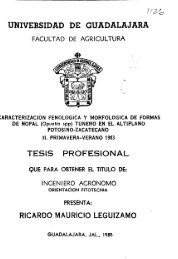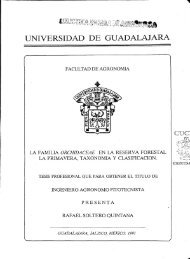Ver/Abrir - Biblioteca CUCBA UdeG - Universidad de Guadalajara
Ver/Abrir - Biblioteca CUCBA UdeG - Universidad de Guadalajara
Ver/Abrir - Biblioteca CUCBA UdeG - Universidad de Guadalajara
You also want an ePaper? Increase the reach of your titles
YUMPU automatically turns print PDFs into web optimized ePapers that Google loves.
53CUADRO No. 15.- REC01·1ENU/\CIONES P.l\Rl1 EL COl'JTHOl DE: ENFERi'IEDAüES ENCULTIVOS DE PAPA. CICLO INVIERrJO 75/76 (ZONA I'•EDIA)NDi'íBRE COI'íUN VNm18RE TECi~ICOTiz6n TardíoPhytophtorainfestanaTizón TempranoAlternarlaaolaniCOF'lO COf•18ATIRLAApliquese fungiéidas abase <strong>de</strong> ~·Janeb y Zinc -1 a 3 kilogramos por -hectáreas en tratamien-toa sewanales 6 menoscuando la prccipitac16npluvial sea frecuente.Aplique ~lanzete O 60,polvo 11umectable, 1 a2 kilogramos por hect§reacon agua sufi-ciente para una hcc-t6rea.DAf,io QUE CAUSAEnferr.JEdad fungoza, -causa lesiones oscurasy circulantes en el -follaje, que crecen -formando un halo ver<strong>de</strong>pálido en el envés<strong>de</strong> la hoja un "polvillo"blanco <strong>de</strong>· espo-rss. La mancha es enhojas, peciolo y ta-llos, <strong>de</strong>struyendo laplanta en poco tiempo.Causa manchas oscurasen el follaje, a manera <strong>de</strong> anillos concéntricosy <strong>de</strong> forma ---oval o angular <strong>de</strong> ---tres a cuatro mil!metras<strong>de</strong> diámetro. Launión <strong>de</strong> las lesionespue<strong>de</strong> causar <strong>de</strong>strucción<strong>de</strong> las plantas.Las lesiones se pre-sentan también en eltallo.
















